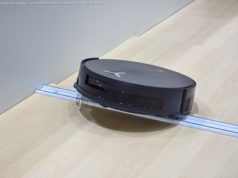The Samsung Galaxy Watch is a feature-packed smartwatch that boasts a heart rate monitor, LTE connectivity, fitness tracking, and a slew of other features without sacrificing battery life.
The Samsung Galaxy Watch promises to fix what’s always been a sticking point for smartwatches: battery life. Promising five days of power, the Tizen-based Galaxy Watch also offers fitness and sleep tracking, heart rate monitoring, and intelligent notifications with Bixby integration. LTE versions will also be available through wireless carriers. We spent some time with the Galaxy Watch at Samsung’s Note 9 launch event and have some initial impressions.
The Galaxy Watch isn’t that different from the Gear S3 in terms of physical appearance. Both watches have a circular rotating bezel around a crisp 1.3-inch AMOLED screen. Available in 42mm and 46mm sizes, the Watch looks stylish on the wrist, with a more professional look than the sporty appearance you get with many fitness-oriented wearables.
There are three color options. One is all black, including the wrist strap; another has a silver metal body with a black strap; and a third is rose gold with a white strap. The wrist strap is textured and flexible, and presumably can be swapped out for leather or metal.
In terms of size and weight, the Galaxy Watch is on the chunky side. The 46mm version felt huge when I tried it on, swallowing my wrist like I was wearing a small hockey puck. The 42mm is definitely more reasonable.
All models of the watch are rated IP68 for dust and water resistance, as well as MIL-STD -810G for durability. A pane of scratch-resistant Corning Gorilla Glass DX+ protects the screen.
Aside from sheer inertia, part of the reason I’ve held onto my Pebble Time for so long is that its battery can last for days. This is something Samsung is addressing with the Galaxy Watch. The 42mm version should be able to last for up to five days of use on a single charge, while the 46mm can last even longer, though Samsung says these estimates are based on “typical use.” Naturally, using LTE and other features will zap your battery faster. When you run out of battery, the watch supports wireless charging.
Under the hood, you have a capable processor and a slew of sensors for fitness tracking, sleep tracking, and heart rate monitoring. The watch also has Bixby integration and works well when paired with a Galaxy Note 9, giving you a daily briefing on the weather, news, appointments, and other important items.
Through the day you’ll get reminders to keep moving, log calories, or drink water through the Samsung Health app. When the watch notices something like your heart rate rising, it might give you advice to get it under control, like breathing exercises you can do. And when it comes to working out, the watch will automatically start tracking when it detects activity, and can even tell when you switch what you’re doing. It’s able to identify up to 40 workouts and supports GPS for running.
Samsung is going big on smart home integration, so like the Note 9, the Galaxy Watch can interact with your various smart devices through the SmartThings app. You can get notifications from your security camera, refrigerator, or washing machine, for instance, depending on what you have at home.
The Samsung Galaxy Watch will work with Android and iOS, though certain features like Samsung Pay will only work with Android. We don’t have pricing info or release dates yet, but we expect the LTE carrier models to cost more than the base Wi-Fi model. The 46mm version is also going to be a bit pricier than the 42mm model. We’ll update this page as more information becomes available, so check back soon.






